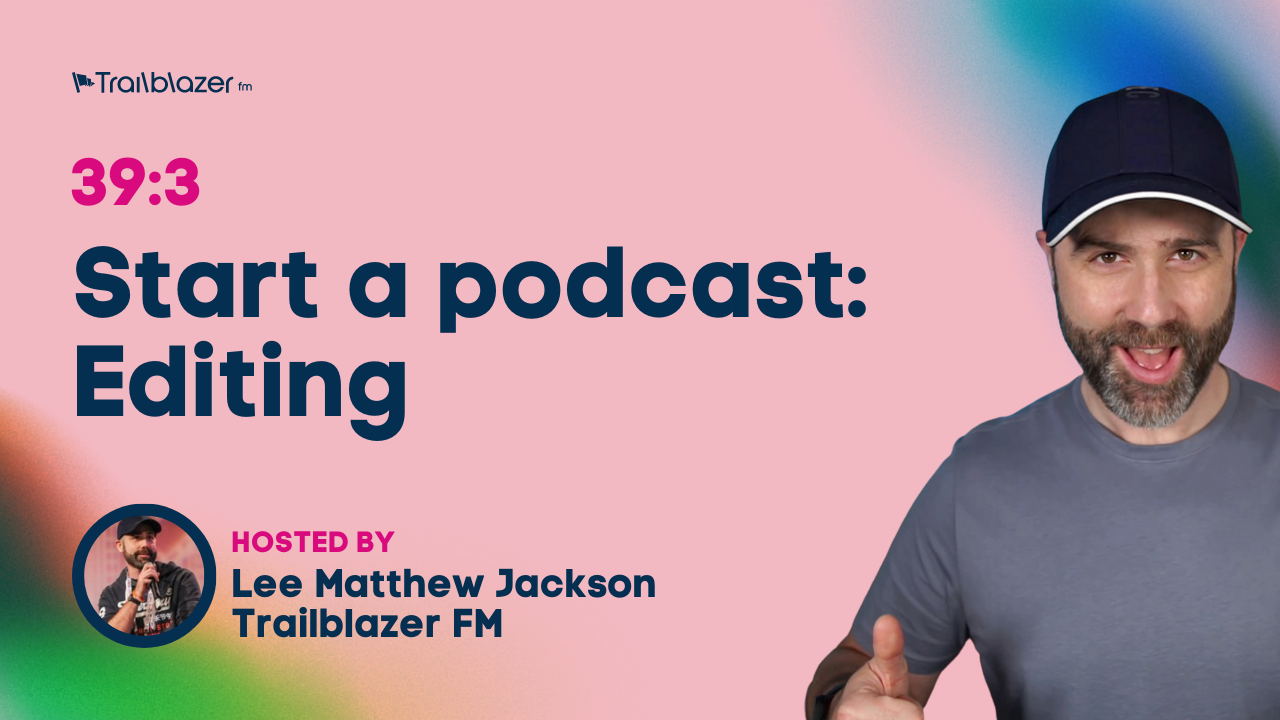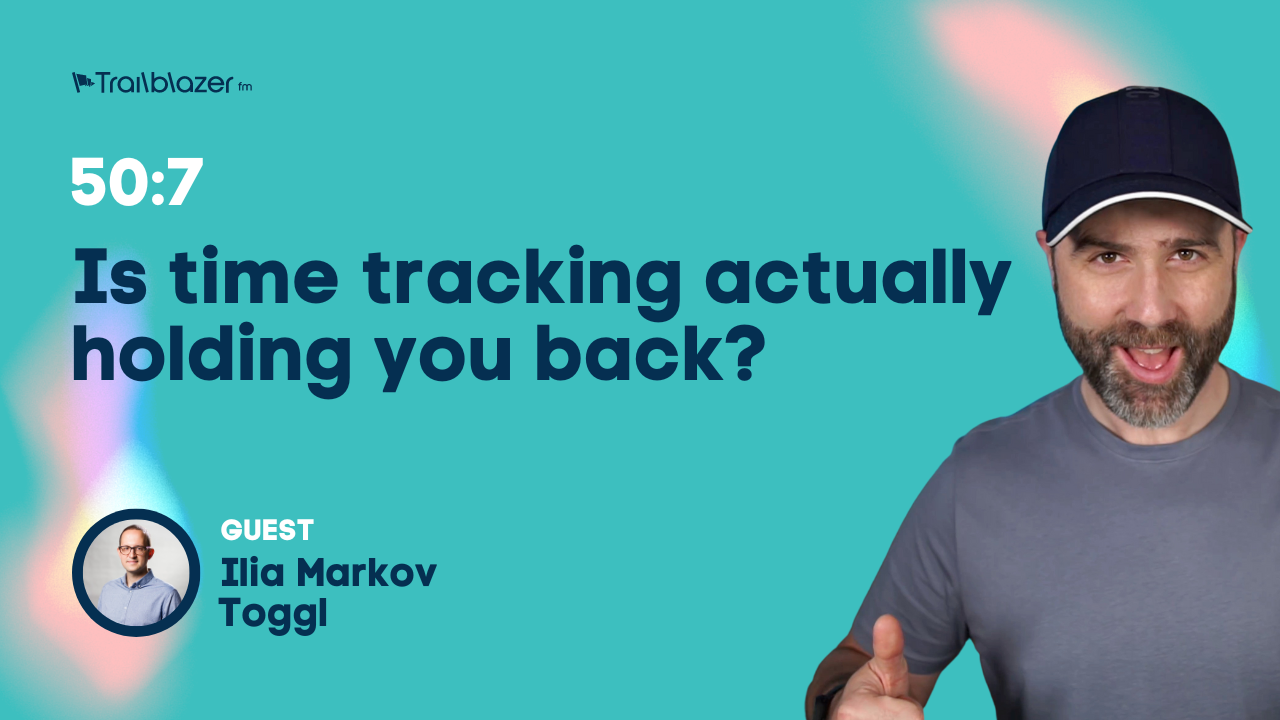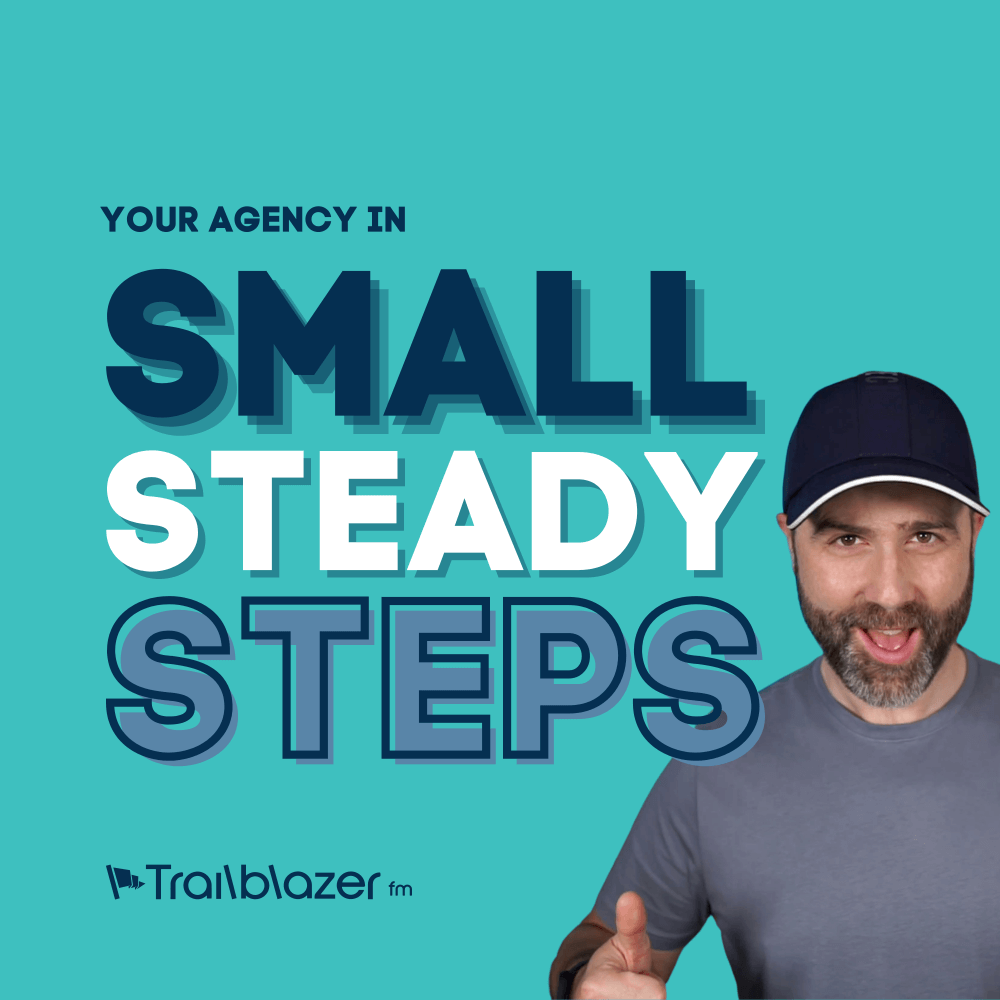
39:3 How to start a podcast – Editing
This week we will unpack the process for editing your audio files and compiling your podcast. We focus Audacity, an open source and cross platform audio editor however the tips in here will work for most professional applications.
This week we will unpack the process for editing your audio files and compiling your podcast. We focus Audacity, an open source and cross platform audio editor however the tips in here will work for most professional applications. As with our other episodes, we are focused on helping you get the MVP podcast up and running, so we don’t beat around the bush.

We will look at:
- Audio editing software
- Recording solo elements
- File formats
- Effects / Audio cleaning
- Music
- Intro and outro
- Advertisements
- Exporting
- Show notes
- Transcription
I’d encourage you to stick with me even if you intend to outsource podcast editing. This episode will give you a basic understanding of the workflow and the structure of a show so should make briefing in what you want much easier.
Resources
Watch how I plan my content and record in Audacity
Pat Flynn’s tutorial on podcast editing within Audacity
Transcript
312 – How to start a podcast – Editing
Introduction
Welcome to the Agency Trailblazer Podcast, this is your host Lee and in today’s show we’ll be looking at how to edit your new podcast.
Before we continue, I’d like to thank Cloudways for sponsoring this episode. Cloudways are the Managed Cloud Hosting service we trust with our mission critical projects. You can find out more on trailblazer.fm/cloudways.
In last weeks episode we looked at the hardware and software you would need to record an interview or panel based podcast. This week we will unpack the process for editing your audio files and compiling your podcast.
We will look at:
- Audio editing software
- Recording solo elements
- File formats
- Effects / Audio cleaning
- Music
- Intro and outro
- Advertisements
- Exporting
- Show notes
- Transcription
I’d encourage you to stick with me even if you intend to outsource podcast editing. This episode will give you a basic understanding of the workflow and the structure of a show so should make briefing in what you want much easier.
Audio editing software
There are so many applications available that it makes sense for us to focus on the one tool we’ve used for 100s of episodes. It is free, open source and cross platform meaning if you own a computer you can use it.
The tool is called Audacity and you can find a link to it in the show notes. The product is nearly as old as me at 20 years old! This makes for a mature, well supported and widely adopted programme with plenty of online tutorials and community support.
Most audio editing tools will do a great job of editing your audio, and whilst in this episode I will focus on Audacity, you will likely be able to do everything shared within the context of your preferred tool.
My key uses for Audacity are:
- Record solo shows
- Record solo voice elements
- Mix audio for the final product
Recording solo elements
If you have a good microphone, (check out last weeks episode), then it makes sense to record your solo shows or voice clips for ads directly into Audacity.
First connect your microphone, then open Audacity and select your microphone in the dropdown labelled with a microphone icon. You should also see a volume slider next to another microphone. I’d recommend putting this at 50% as you’d run the risk of recording too loudly causing clipping. It’s always easier to bring the volume up in post than it is to fix audio that is clipping and distorted.
When you begin recording, be sure to leave approximately 5 – 10 seconds of silence. This will record the ambience of the room allowing you to sample any background noise later in order to remove any electrical buzzing or natural hisses.
Go ahead and record your solo content or clip speaking directly into your microphone. If you make a mistake you can either pause and start over or you can stop, cut the mistake out and then continue recording. I prefer to stop, cut and continue so that by the time I’ve finished my recording I don’t have to then listen to everything over again in order to find where I messed up.
I also highly recommend that you save your project at the earliest point you can and continue to save it during the recording process.
File formats
When you save your project, you will be saving it in the file format of your audio editor at first. In the case of Audacity that is an “.aup3” file. With the latest version of Audacity, this format ensures all recordings and assets are combined into one large file allowing for portability from machine to machine if you need others to collaborate with you.
If you are importing files you’ve recorded elsewhere, or importing music etc, then mp3 is perfectly fine. People would recommend raw WAV files, and if you have a lot of space and a powerful machine, then feel free. We’ve found perfectly acceptable audio quality however importing mp3 recordings and sound tracks that we can mix together.
Effects / Audio cleaning
As this is an audio podcast, I can’t show you how to actually edit, clean, cut, crop, mix and apply effects to your show, but I can describe our basic process and in the show notes I will be sure to link to existing tutorials for Audacity specifically.
Once we record some audio or import the audio of one of our guests we do the following:
- Normalise the audio
- Sample background noise
- Run the noise removal tool
- Add Bass through the Graphic Equaliser tool
- Use amplification to make the track louder or quieter depending on the sound levels of other guest audio or soundtracks.
Each track is layered and we move them around for most episodes in the following format:
- Music intro
- Intro voice recording
- Main show recording (solo or interview)
- Outro voice recording
- Closing music
Using the timeline we ensure there is a slight overlap for the opening title and my welcome message, then for our closing outro, we have the music set to start 1 minute out from the end of the show and we bring the volume up at the end when I’ve wrapped up.
This is a very simple, repeatable format that is easy to replicate and to teach others. Your experience may be different if you are using different tools, or wish to get more complicated with your mix.
I’d recommend for your MVP podcast to keep it as simple as possible. For example, we don’t even record an opening sting any more as we found many people skip it anyway. The only people who like the opening music, tends to be the podcast host who paid good money to get it recorded.
Music
It is super important you get licensed music. Audio Jungle and Audio Hero are two places we’ve gone to purchase a low cost licence to Royalty Free music for the podcast.
Whilst there are many free resources out there, we’ve been unwilling to risk it and have felt more comfortable doing our due diligence and paying for a licence. Costing anything from $5 to $50 it’s a worthwhile investment especially as in most circumstances that’s a one of payment and you can reuse the audio for many episodes. (Be sure to read the terms and conditions of any audio you purchase for use).
As with this show, recording a long mixed audio introduction is not needed for an MVP, therefore if you wish to copy our format, simply search for a short “logo” that is approx 10 – 15 seconds long.
Intro and outro
Once you have your intro music nailed, you will want to sandwich the recording with an intro that sets the scene, and an outro that wraps up with relevant call to actions. When I record a solo show, I naturally do these as part of the one recording, however in a pre-recorded interview I will have to record the individual intro and outro to mix in in post.
When considering what we want to say during our intro and outro we’ve created the following format:
Intro
- Welcome to show name
- Intro the host
- Set the topic
- Sponsor message
- On with the show
Outro
- Basic recap
- Sponsor thank you
- Call to action (comments/review/download)
- See you next week
Advertisements
You will notice that we do include space for a sponsor message. Depending on your agreement you may be recording a personal thanks or message for your sponsor, or be including their pre-recorded audio. We prefer to use our own messaging or audio and our awesome sponsor Cloudways have always been very supportive.
Remember that there is no shame in sponsorship, you are providing value and you also have to keep the lights on and put food on the table. Our sponsorship is non intrusive and ensures we keep producing high quality content.
If you don’t have a sponsor to start with, consider yourself a sponsor and feel free to promote your own business and services if it’s appropriate to the target audience. Alternatively recommend affiliate links to products that you know and love that help you monetise your podcast if that is a part of your goal.
Exporting
When you do export the final mixed audio file of your show, you will want to select “File” and “Export as MP3”. We select “Standard Quality” which ensures the MP3 is not too large but the audio quality is good, we create a file name and hit save.
The final step is the most important. Audacity will ask you for relevant meta data. This includes items such as:
- Artist name
- Track title
- Album or podcast title
- Track number
- Genre etc
This meta data is used by many audio players thus giving listeners context to what they are listening to. It is also used by some podcast hosting companies who will parse the information during import and use it as part of your show meta.
Show notes
Whilst not part of your audio, we ensure we write our core show notes as soon as we’ve either recorded the solo audio, or we’ve finished mixing the overall interview or panel episode. We’ve had time to listen to the recordings, digest it’s content and it’s much easier to summarise the episode in a compelling paragraph there and then, rather than coming back to it a few days later.
I’ve been known to write part of the show notes during an interview or a recording as certain products or websites are mentioned so I can add them to the “resources” section.
In our experience, a couple of paragraphs that set the scene, contact details of any guests and a list of mentioned resources are enough for most episodes. Podcasting is an audio format, and most people will be consuming on the go and potentially via a smart device, so reading paragraphs of descriptive content may not be top of their list.
Transcription
Finally it’s super important to include a transcription of your show. I take my hearing for granted and yet I soon discovered there were people who wanted to follow my podcast who had hearing difficulties. Using automated captioning would be hit or miss for them and a few reached out to find out if I’d be willing to start transcriptions.
I’ve ensured we get a professional transcription ever since and whilst you can do this yourself, I’d recommend rev.com who will take your audio and are super reliable in turning around a full transcript of your episode. They even let you know of anywhere they struggled to understand audio and provide a timestamps for you to clarify.
Over the year’s I’ve also built a glossary with them which has sped up the process of transcription as they are able to utilise words I use regularly.
They do offer an AI powered version of which we have used in the past if we have internal resource to then read through carefully in context of the audio however as you may be aware from previous episodes I’ve a few members of the team either off or committed to projects so I’ve been outsourcing as much as I can.
Another benefit (so I am told) of transcripts is SEO but being someone who’s confessed to not really understanding SEO or focusing much on it for years despite multiple attempts, you can take that with a pinch of salt!
In closing
You should be ready to explore the tools mentioned in this episode and why not have a go at recording and mixing your very first episode?
If you have any questions, please visit us on trailblazer.fm and connect with me in the comments on Episode 312.
Thank you again to Cloudways for sponsoring this episode.
Folks if we don’t connect in the comments, then let’s see you in next week’s episode!
[1] https://trailblazer.fm/cloudways Cloudways








